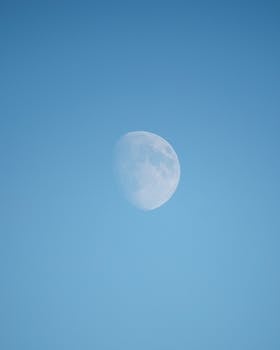

-
Table of Contents
Visible in the Sky: Unveiling the Beauty Above.
Introduction
Visible in the Sky is a phenomenon that refers to the ability to see celestial objects, such as stars, planets, and other astronomical bodies, with the naked eye from Earth's surface. This includes objects that are visible during both day and night, depending on their brightness and position in the sky. The visibility of these objects can vary based on factors such as atmospheric conditions, light pollution, and the time of year. Observing celestial bodies in the sky has been a source of fascination and wonder for humans throughout history, and continues to be a popular activity for stargazers and astronomers alike.
Exploring the Phenomenon of Shooting Stars: A Guide to Observing and Understanding
Visible in the Sky
Exploring the Phenomenon of Shooting Stars: A Guide to Observing and Understanding
Have you ever gazed up at the night sky and been captivated by the sight of a shooting star streaking across the darkness? This awe-inspiring phenomenon has fascinated humans for centuries, sparking curiosity and wonder. In this article, we will delve into the world of shooting stars, providing you with a comprehensive guide to observing and understanding these celestial events.
First and foremost, it is important to understand what exactly a shooting star is. Contrary to popular belief, shooting stars are not stars at all. In fact, they are tiny particles, often no larger than a grain of sand, that enter Earth's atmosphere at high speeds. As these particles collide with the air molecules, they heat up and create a luminous trail, resulting in the mesmerizing streak of light we see from the ground.
To increase your chances of witnessing a shooting star, it is crucial to find a location with minimal light pollution. Light pollution from cities and towns can greatly diminish the visibility of these celestial events. Therefore, heading out to a remote area, away from the bright lights, will provide you with the best opportunity to observe shooting stars in all their glory.
Once you have found a suitable location, it is time to prepare for your observation. Dress warmly, as stargazing can be a chilly endeavor, especially during the nighttime hours. Bring a comfortable chair or blanket to sit or lie on, allowing you to relax and fully immerse yourself in the experience. Additionally, consider bringing a star chart or a smartphone app that can help you identify constellations and other celestial objects.
As you gaze up at the night sky, keep in mind that shooting stars are not a constant occurrence. On average, you can expect to see around 10 to 20 shooting stars per hour during a meteor shower. Meteor showers are periodic events that occur when Earth passes through the debris left behind by comets or asteroids. These showers often have specific peak dates, so it is advisable to consult an astronomical calendar to plan your observation accordingly.
When a meteor shower is active, it is best to observe during the darkest hours of the night, typically after midnight. During this time, the moon is less likely to interfere with your viewing experience, allowing shooting stars to shine brightly against the backdrop of the night sky. Patience is key when observing shooting stars, as they can be sporadic and unpredictable. It may take some time before you spot your first one, but once you do, the experience will be well worth the wait.
As you witness a shooting star, take a moment to make a wish. This age-old tradition adds a touch of magic to the already enchanting event. Whether you believe in the power of wishes or not, it is a delightful way to engage with the shooting star and create a personal connection to the vastness of the universe.
In conclusion, observing and understanding shooting stars is a rewarding and awe-inspiring experience. By finding a location with minimal light pollution, preparing for your observation, and being patient, you can increase your chances of witnessing these celestial wonders. Remember to consult an astronomical calendar for meteor shower dates and to bring a star chart or smartphone app to enhance your stargazing experience. So, next time you find yourself under a clear night sky, take a moment to look up and marvel at the beauty of shooting stars.
Unveiling the Mysteries of the Northern Lights: A Journey into the Enchanting Aurora Borealis

Visible in the Sky
The Northern Lights, also known as the Aurora Borealis, have captivated humans for centuries. These mesmerizing displays of light in the night sky have sparked countless myths and legends, and continue to inspire awe and wonder in those lucky enough to witness them. But what exactly are the Northern Lights, and how do they come to be?
The Northern Lights are a natural phenomenon that occur in the polar regions of the Earth. They are caused by the interaction between the Earth's magnetic field and charged particles from the sun. When these charged particles, also known as solar wind, reach the Earth's atmosphere, they collide with atoms and molecules, causing them to emit light. This light is what we see as the Northern Lights.
The colors of the Northern Lights can vary, but the most common colors are green, yellow, and red. The green color is caused by oxygen molecules in the atmosphere, while the red color is caused by oxygen atoms at higher altitudes. The yellow color is a combination of both green and red light. Occasionally, the Northern Lights can also appear in shades of blue and purple, although these colors are less common.
The intensity and frequency of the Northern Lights can vary depending on a number of factors. One of the most important factors is the activity of the sun. During periods of high solar activity, such as during a solar storm, the Northern Lights can be more intense and visible at lower latitudes. Conversely, during periods of low solar activity, the Northern Lights may be less frequent and less intense.
Another factor that can affect the visibility of the Northern Lights is the weather. Clear, dark skies are ideal for viewing the Northern Lights, as any light pollution or cloud cover can obscure the view. It is also important to be in a location with a high latitude, as the Northern Lights are more commonly seen closer to the poles.
For those lucky enough to witness the Northern Lights, the experience can be truly magical. The dancing lights in the sky create a sense of awe and wonder, and many people describe the experience as spiritual or otherworldly. The Northern Lights have inspired countless myths and legends in cultures around the world, and continue to be a source of inspiration for artists and writers.
In recent years, the Northern Lights have also become a popular tourist attraction. Many people travel to the polar regions in the hopes of catching a glimpse of this natural wonder. There are even specialized tours and accommodations that cater to Northern Lights enthusiasts, offering the best chances of seeing the lights in all their glory.
In conclusion, the Northern Lights are a natural phenomenon that occur in the polar regions of the Earth. They are caused by the interaction between the Earth's magnetic field and charged particles from the sun. The colors of the Northern Lights can vary, but the most common colors are green, yellow, and red. The intensity and frequency of the Northern Lights can vary depending on solar activity and weather conditions. For those lucky enough to witness them, the Northern Lights are a truly magical experience that inspire awe and wonder. Whether you are a scientist studying the physics behind the lights or a traveler seeking a spiritual connection with nature, the Northern Lights are a sight to behold.
The Fascinating World of Celestial Events: Witnessing Meteor Showers and Eclipses
Visible in the Sky
The night sky has always held a sense of wonder and mystery for humanity. From ancient civilizations to modern astronomers, people have been captivated by the celestial events that occur above us. Two of the most awe-inspiring events are meteor showers and eclipses, which offer a glimpse into the vastness and beauty of the universe.
Meteor showers, also known as shooting stars, are a breathtaking display of celestial fireworks. They occur when the Earth passes through the debris left behind by comets or asteroids. As these tiny particles enter our atmosphere, they burn up, creating streaks of light across the sky. Meteor showers are named after the constellation from which they appear to originate, such as the famous Perseids or the Leonids.
To witness a meteor shower, all you need is a clear, dark sky and a bit of patience. Find a location away from city lights, as light pollution can hinder your view. Lie down on a comfortable surface and allow your eyes to adjust to the darkness. Meteor showers are best observed during the peak times, which can vary depending on the shower. It is advisable to check online resources or consult an astronomy guide to determine the best time to witness a specific meteor shower.
Eclipses, on the other hand, are celestial events that occur when one celestial body passes in front of another, blocking its light. The most well-known type of eclipse is a solar eclipse, which happens when the Moon passes between the Earth and the Sun, casting a shadow on the Earth's surface. During a total solar eclipse, the Moon completely covers the Sun, revealing the Sun's corona, the outermost layer of its atmosphere.
To witness a solar eclipse, one must take precautions to protect their eyes. Looking directly at the Sun during an eclipse can cause permanent damage to the eyes. Special eclipse glasses or solar filters are necessary to safely observe this phenomenon. It is also important to be in the path of totality, the area where the eclipse is visible in its entirety. Outside of this path, only a partial eclipse can be seen.
Lunar eclipses, on the other hand, occur when the Earth passes between the Sun and the Moon, casting a shadow on the Moon's surface. Unlike solar eclipses, lunar eclipses are safe to observe with the naked eye. They can be seen from anywhere on Earth where the Moon is visible during the eclipse. The Moon takes on a reddish hue during a total lunar eclipse, earning it the nickname "blood moon."
Witnessing a celestial event like a meteor shower or an eclipse can be a truly awe-inspiring experience. It reminds us of our place in the universe and the beauty that exists beyond our planet. These events also serve as a reminder of the constant motion and interaction of celestial bodies, offering a glimpse into the workings of the cosmos.
Whether you choose to lie under the stars and watch shooting stars streak across the sky or don special glasses to witness the dance of the Sun and the Moon, celestial events are a testament to the wonders of the universe. So, mark your calendars and prepare to be amazed as you witness these captivating displays visible in the sky.
Q&A
1. What is Visible in the Sky?
Visible in the Sky refers to celestial objects that can be seen with the naked eye from Earth, such as the Sun, Moon, stars, planets, and sometimes even comets or meteor showers.
2. What are some examples of objects that are visible in the sky?
Examples of objects visible in the sky include the Sun, Moon, Venus, Mars, Jupiter, Saturn, constellations like Orion or Ursa Major, and shooting stars during meteor showers.
3. When can these objects be seen in the sky?
Visible objects in the sky can be seen at different times depending on their specific characteristics. For example, the Sun is visible during daylight hours, while stars and planets are typically visible at night. The Moon can be seen both during the day and at night, depending on its phase.
Conclusion
Visible in the Sky is a phenomenon that refers to objects or celestial bodies that can be seen from Earth's surface. These objects include stars, planets, the Moon, and even man-made satellites. The visibility of these objects depends on various factors such as their distance from Earth, their brightness, and atmospheric conditions. Overall, the visibility of objects in the sky provides a fascinating opportunity for stargazing and observing the wonders of the universe.












